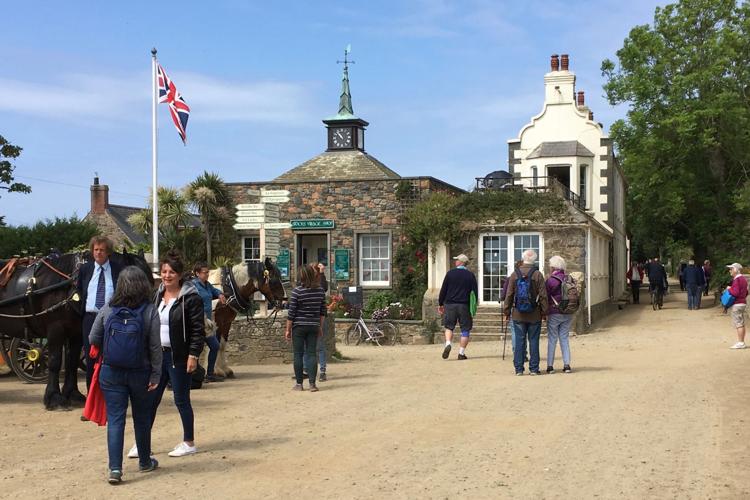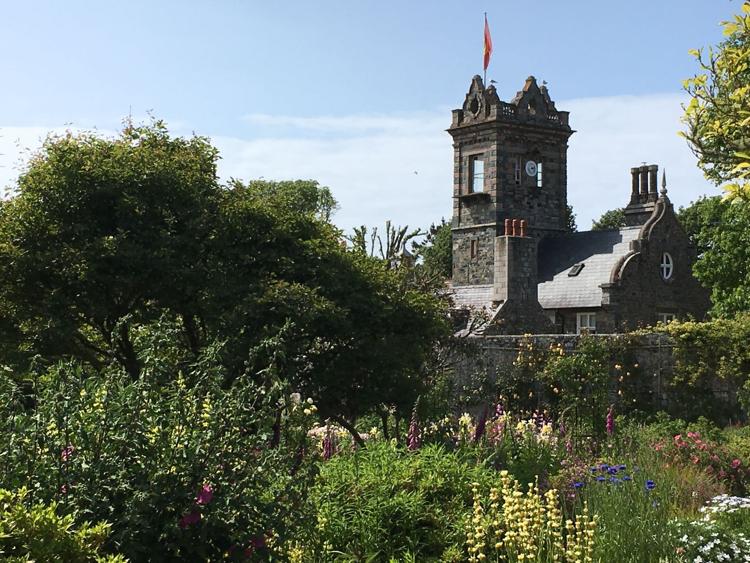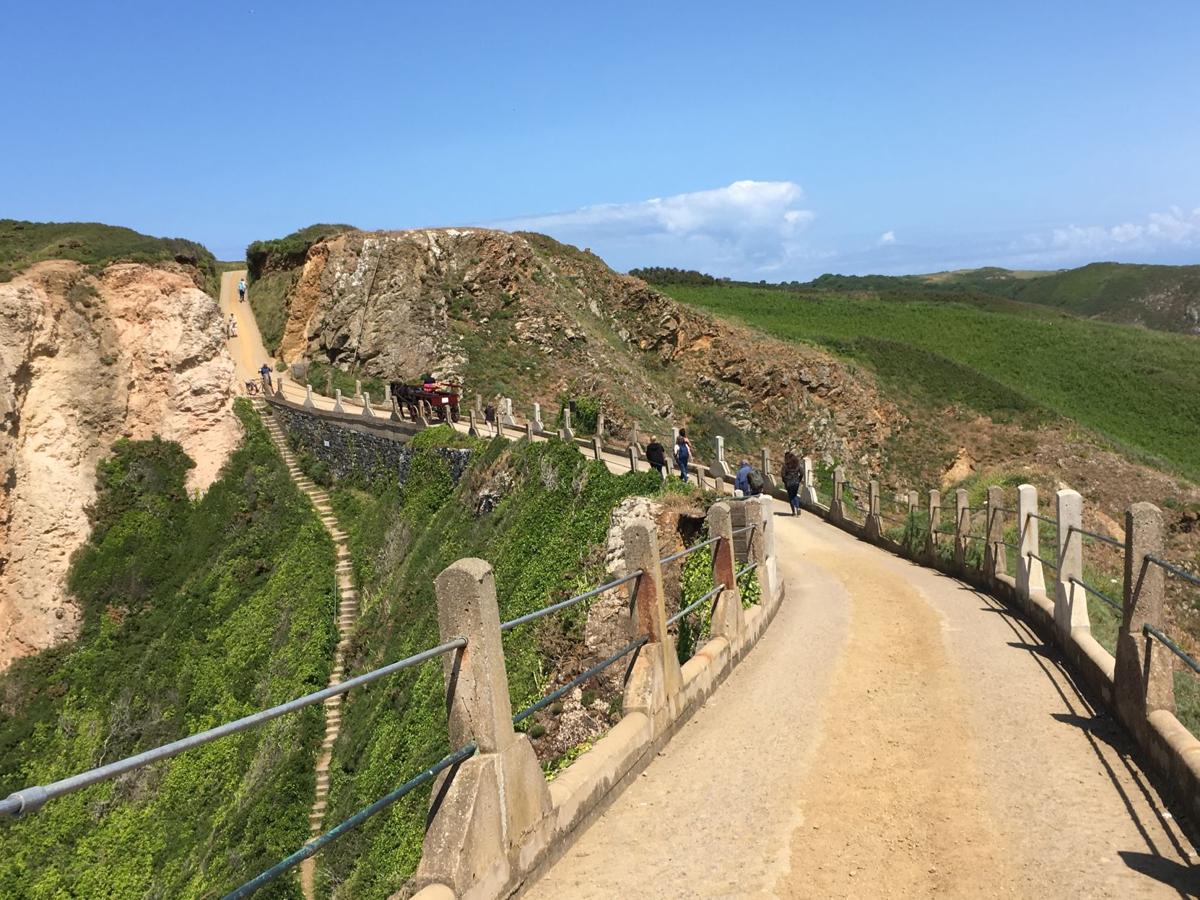Found in the English Channel, Sark is a fascinating, history-rich island

Sark’s lushness is revealed right off the ferry when seeing plants and flowers in front of the island post office.
Janet Podolak
Sark is an enchanted isle lost in time, floating like a mirage in the English Channel.
Although a magical place for today’s visitors, it was Europe’s last bastion of the medieval feudal system, which ended there only in 2008.
The feudal system was formed in 1563, when sovereignty over the island was granted by English monarch Elizabeth I to Helier de Carteret in exchange for maintaining a militia that would keep Sark free from pirates who were using it as a base to harass English Channel shipping. Each of the 40 men recruited from the neighboring island of Jersey was granted tenancy to one of 40 parcels of land. That land largely has remained in the same families since.
Wildflowers drift over lands where horse-drawn carriages remain the transportation of choice along with bicycles and foot traffic. No cars ply the dusty lanes.The island’s only motorized vehicles are tractors, an ambulance and four-wheel mobility scooters.

Horse-drawn carriages, at left, await those who have just arrived on Sark by ferry from Guernsey.
Janet Podolak
Sheer cliffs lead to pristine beaches revealed only at low tide and reached by precarious footpaths. Hedgerows separate Sark’s whitewashed stone cottages and shops — many dating from the 16th century. Ever-present flowers and mosses sprout from these stone walls held together with earth and enclosing brown-and-white Guernsey cattle and shaggy sheep in their own meadows.
Surnames and place names often are French — reflecting Sark’s geographical proximity to the French coast of Normandy and its history of a now-lost language that was a French-English patois.
Its seigneur is today an honorary position, as Sark’s 400 residents now are governed by a democracy.
“Call me Christopher,” says Christopher Beaumont, the 23rd seigneur of Sark, to our small group of writers, here to explore Sark and see La Seigneurie, his gracious ancestral home and its impressive gardens. He inherited the position of leader of its feudal system. Again, it’s mainly an honorary title, but he’s still the one who holds Sark in perpetuity for the crown and pays the English monarch an annual rent of less than 2 pounds sterling for the island.

The roofs of La Seigneurie, home of Sark’s seigneur, are seen through the foliage of the mansion’s walled garden, considered some of the best in Europe.
Janet Podolak
Beaumont knew from the time he was a boy that he was destined to step into Sark’s leadership at the death of his father, just as his son, a doctoral candidate in physics back in London, faces the same future. Today the leadership works on issues such as renewable energy, revenues and preserving the artifacts of the island’s long history.
Although Sark has a number of overnight accommodations, including camping, for those who come to hike, feast on its bountiful seafood, spot puffins and other birds and enjoy its beaches, most come as daytrippers from Guernsey, an hour’s ferry ride away.
Arrival at Maseline Harbor involves a climb up the cliffs by stairway to a pedestrian tunnel that leads through more cliffs. Beyond, tractors hitched to open-sided wagons await with seats for a dozen or more passengers. Pay a pound or two for a ride up a steep hill or follow the lane-side paths and climb to the top through prolific stands of flowers.
Horse-drawn wagons, some reserved for those with luggage await. They carry visitors on narrated tours around the island — a touring style that allows good viewing over the hedgerows.

Hedgerows, which combine ancient stone walls with soil sprouting moss and flowers, line the lanes of Sark. They’re easier to see over when touring by horse-drawn carriage.
Janet Podolak
Bikes can also be rented and many come to explore on foot.
Our carriage driver told us that Sark, despite its diminutive 2-square-mile size, has more than 42 miles of coastline. He pointed out places we would later walk.
We also learned a boat tour around the island, and into some of its caves at low tide, is possible.
One of the most delightful places on the island is actually on Little Sark, a neighboring island reached by taking La Coupée, a narrow roadway over a knife-sharp ridge with steep drops to beaches on either side.
We were told that at one time in high winds, school children had to crawl across single-file. La Coupée has since gotten safety rails, but bicycles must be dismounted and walked over the narrow path, and horse-drawn carriages must cross without their passengers. We climbed down from the carriage to make the walk, admiring the view of the Caribbean-blue sea lapping the wide beach below.

La Coupée, a narrow path over a knife-sharp ridge, must be negotiated on foot because carriages aren’t permitted to cross with passengers. The steep pathway down the left side leads to one of the best beaches exposed when tides are low.
Janet Podolak
Our carriage awaited on the other side to take us to lunch at La Sablonnerie Hotel and Tea Gardens, where we met the delightful owner and manager, Elizabeth Peree. The hotel, opened by her parents in 1948, grew from the buildings of a 16th-century farm where she spent an idyllic childhood. Its low ceilings, wood beams, and plentiful fireplaces provide a cosy atmosphere of public spaces for its 22 guest rooms, several of which are in free-standing cottages.

Lunch is served in the gardens surrounding La Sablonnerie Hotel, an acclaimed inn built from a 16th-century farm.
Janet Podolak
Peree grew up learning hospitality first-hand, then spent her early 20s in culinary school at Le Cordon Bleu London. She took over management of La Sablonnerie in her mid-20s and has since developed it into a Michelin-starred restaurant and highly ranked country hotel.
“La Sablonnerie means ‘place of sand’ in French,” she told us.

La Sablonniere on Little Sark began as a 16th-century stone cottage. Today it’s a 22-room inn and an excellent place for a meal.
Courtesy Guers
After welcoming us with Champagne and escorting us into the garden, she suggested the Sark seafood options for our lunches. We dined among others at tables scattered on the lawns and beneath the shady trees.
My half-lobster with lime and ginger glaze was, without a doubt, the best meal I’ve ever eaten.

My lunch of fresh Sark lobster grilled with a lime and ginger butter glaze on the La Sablonnerie menu was the best thing I’ve ever tasted.
Janet Podolak
“It was caught two hours ago,” Elizabeth told us, adding she’d developed that recipe and many others.
Sark lobster is well-regarded on the neighboring island of Guernsey and served at several of its restaurants.
La Sablonnerie is open from April to October and sends its own carriage to meet guests as the ferry. Some of them stay the entire summer.




Recent Comments